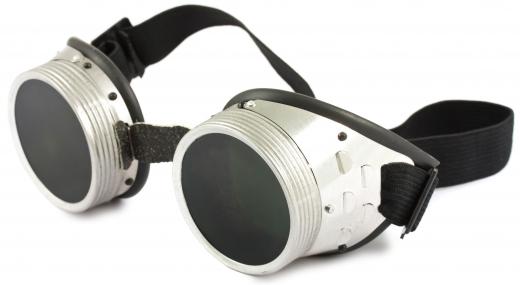At AboutMechanics, we're committed to delivering accurate, trustworthy information. Our expert-authored content is rigorously fact-checked and sourced from credible authorities. Discover how we uphold the highest standards in providing you with reliable knowledge.
What is TIG Welding?
Tungsten inert gas (TIG) welding is the process of blending together reactive metals, such as magnesium and aluminum. During the welding process, an arc is formed between a pointed tungsten electrode and the area to be welded. A shielding gas is used to help create a clean weld, as it prevents oxidization from occurring. The welding method became popular and useful in the early 1940s and, as a result, has greatly propelled the use of aluminum for welding and structural processes. It is commonly used for both high quality and manual welding.
The type of gas shielding typically used for TIG welding is argon, helium, or a combination of both. When combined, these two gases can ensure a higher welding speed and welding penetration. Argon is usually preferred by most welders simply because it is heavier than air and provides better coverage when welding.

Using the TIG welding process, a person can perform a variety of weld types on a number of different metals, although steel and aluminum are the most widely used. A filler rod, usually made from the same material as the base metal, is used for reinforcing joints and welding heavy metals.
There are several different types of joints designed for use with this method of welding, including the butt joint, lap joint, corner joint, and t-joint. The butt joint, which can be welded without the assistance of a filler rod, involves two pieces of metal being joined together along the seams. With a lap joint, the top edge is welded to the bottom piece in an area between the two overlapping metals. A corner joint involves welding one piece of metal at a right angle to the edge of a second piece of metal in order to form a corner. The t-joint is created by placing one piece of metal perpendicular to another piece of metal to form a T shape, and it does require a filler rod. This type of welding is done along either side of the perpendicular seam.
AS FEATURED ON:
AS FEATURED ON:













Discussion Comments
I'm quite into the idea of engineering equipment being beautiful.
This article hits the "basics" pretty well, but does not go into why use TIG versus other types of welding. TIG welding is as stated before a more difficult form of welding than the more automated MIG, or the more simplistic ARC welding. TIG will require significant skill and practice before being able to produce a sound weld.
TIG also is a less penetrating weld as the filler material is not connected to the welder itself, eliminating electrical preheating or the weld material. This will create more stress in the final weld if not done correctly. Since this is a welding process, you must make the materials molten in order to weld them together, since the filler material must go from cold, to molten, and back to cold, a greater heat affect zone (HAZ) is formed during welding.
The advantages of TIG welding include a much more precise weld (if in the very skilled hands) and it is one of the few welding techniques to spot weld aluminum in custom projects. All other techniques of joining aluminum consist of rivets, fasteners, or a much more difficult process, such as friction stir welding or forged welding.
For anon5250: I am not a pro and I am still learning, so don't take my answer too seriously. TIG welding requires more skills and it is definitely slower than some other types of welding, for example MIG welding.
I am a math and science tutor at a local high school. Could someone please refer me to an excellent math book for welders? I tutor basic math all the way to calculus and physics. Thank you.
I took a welding course where we learned many different types of welding and brazing. MIG welding and ARC welding were among the easiest. There are some tricks associated with each of those, but you basically just drag the tip of the welder along the joint that you are working on.
TIG welding (also known as GTAW welding), was among the hardest. You have to coordinate the action of both hands and have to move the TIG welding electrode in a very controlled manner.
Another huge advantage is that you can use TIG welding on stainless steel which is not possible with other types of welding.
what is the disadvantages of this tig welding?
Post your comments